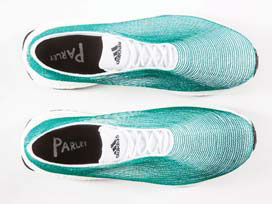Adidas is among the most admired companies in the world, especially when it comes to sustainability. In January, Corporate Knights, “the magazine for clean capitalism,” ranked the sporting goods and apparel giant No. 3 on its list of the “Global 100 Most Sustainable Corporations.” In fact, Adidas was the only textile, apparel or luxury good company that made the list.
The approach that makes this company tick so consistently when it comes to sustainability, despite the financial pressures of the athletic apparel marketplace is open source innovation.
“Consumers make decisions based on the brands they prefer. Sustainability and innovation are two of the key criteria of selection,” Haass said. “Successful companies in the future will be those where sustainability is well integrated in terms of core values, operations as well as consumer acceptance.”
According to Alexis Haass, director of sustainability at the company’s global headquarters in Herzogenaurach, Germany, open source is comprised of crowd sourcing ideas from four pillars within and outside of Adidas”:
• Creators — including athletes and artists.
• Communities — individuals and groups of people who want to work with the company. For example, the Brazuca soccer ball, official ball of the 2014 FIFA World Cup in Brazil, was named by Brazilians themselves.
• Customers — which results in consistent and open communication and feedback.
• Partners — collaboration with other companies, non-profits and NGOs. BASF, a leader in the sustainable chemistry and green sports worlds, worked with Adidas to create a revolutionary new cushioning material, BOOST, that provides the highest energy return in the industry.
One of Adidas’ open source innovation partners sits squarely in the sustainability world: Parley for the Oceans, which has a primary goal of getting plastic out of the ocean.
A key practical effect of the collaboration, which launched in April, will be the integration of materials made from ocean plastic waste into Adidas products in 2016 and beyond.
In fact, Adidas created a first: A shoe upper made entirely of yarns and filaments reclaimed and recycled from ocean waste and illegal deep-sea gillnets.
Adidas is already walking the green walk in terms of its operational sustainability. About 96 percent of the company’s footwear suppliers are ISO (international quality standard) certified. Building performance, CO2 emissions and water usage are all becoming more efficient.
Not Environment Alone
Sustainability also does not only mean environment at Adidas. The issue is looked at through a wider lens of ESG (environmental, social and governmental) issues.
In the run up to the Brazil 2014 World Cup, Adidas focused on the social end of ESG by working with local organizers on a number of grassroots programs, including the “Ginga Social” initiative. This sportsbased initiative uses coaches to teach values and life skills to young people ages 7 to 17 in favelas (lowincome, high-crime neighborhoods) in Rio de Janeiro, Sâo Paulo and three other host cities.
http://www.greenbiz.com/article/how-adidas-pioneeringopen- source-sustainability-sports










